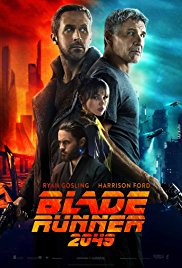
“Every civilization was built on the back of a disposable workforce, but I can only make so many.“
Wallace – a creator of replicants in Blade Runner 2049
Check It Out!
By Nina Heyn, Your Culture Scout
Space exploration is considered to be potentially one of key industries and investment opportunities in the coming years. For anyone interested in space then, let’s take a look at one of the most seminal sci-fi movies and its sequel that has been made 35 years later.
When the original Blade Runner was released in 1982, it was not a box office success. Audiences were flocking to less intellectually complex movies of that year: E.T., 48 Hours and Star Trek-The Wrath of Khan. In time, Ridley Scott’s vision of the world in the year 2019 has come to pass in many aspects and the movie became a sci-fi classic with many of its ideas copied countless times.
The original 1982 movie starred Harrison Ford as a policeman called Deckard, a hunter of rogue replicants – genetically modified androids created as slave labor – who rebelled against their human masters. To quote the opening credit’s scroll: “Replicants were used Off-world as slave labor, in the hazardous exploration and colonization of other planets.” Deckard was called in by the manufacturers to determine if Rachel, a new employee at their company, can pass for a human.
Blade Runner was full of haunting visions of the future: a megacity with cars flying amidst gigantic neon ads, streets lashed with constant acid rain and crammed with mostly Asian inhabitants speaking a new “city-speak” language. Sentient beings and objects have already been merged to great extent. For example, Deckard discovers a snake scale as a clue in his investigation, but a Chinese grandma who is a street vendor crossed with a lab technician identifies it as an artificial skin- a living cell is not what is used to be apparently. There is hardly a sci-fi or a fantasy movie that that did not borrow from Blade Runner: androids in Surrogates and the TV show Westworld, artificial snakes and sort of replicants in Ghost in the Shell, the rebellion of AI against humans in Terminator, a dilemma what it means to be human in Ex Machina and all these visions of megacities of the future that are so familiar to us now as if they already existed.
It is therefore fascinating to take a look at Blade Runner 2049 which is directed by an artist with a completely different sensibility than Ridley Scott, but who is making a story that is a continuation of that world, except 30 years later. Denis Villenuve is a Canadian director of Arrival – an excellent and a very idiosyncratic sci-fi which turns out to be more about a human psychology than aliens.
This is a true sequel in a sense that it reprises some characters and develops the same world further into the future. Most of the mankind has moved “off-world” to some greener colonies because Earth has become mostly uninhabitable after some ecological disaster. Skies over Los Angeles drop either constant rain or snow, parts of the city are covered with orange radioactive dust, the city edge is protected by a huge sea wall since the water level has risen, and nearby San Diego is now one big junkyard half submerged in a wetland. Of course, this being a sci-movie, this vision was created with over a 1200 CGI shots. What is worrisome is that many of the movie’s shots have been created with the use of existing locations. Early in the movie we see an industrial scale farm – acres after acres of land under plastic covers. This was shot on location in Spain. A gigantic junkyard was shot in Hungary. The movie version is enhanced with props and CGI backgrounds but this depressing wasteland does exist for real as well.
Against a background of this vision of a possible future, the central question of the original movie comes back- who is really human and will the future generations be able to preserve this distinction. The first movie hinted at a possibility that Deckard, a cop who is tasked with rooting out non-humans, may be a replicant himself. Film schools’ papers have been written about this issue for decades since the movie came out. The second movie makes no secret that the new hunter is a replicant himself – he does not even have a name – just a letter “K” and a number. His quest is a pursuit of a possibility that he might actually be a human after all. The story made a big circle. Replicants- those perfect products of AI that we are starting to create, have the same desires as humans – to have parents who raise them rather than to be raised in orphanages, to make their own decisions rather than to be slaves, and even to die on their own terms. Basic human rights… Not easy to have them here and now, much less in the world of Blade Runner 2049.
Food for the Soul Series
Food for the Soul: Pacific Standard Time LA/LA
Food for the Soul: Wolf Warrior 2
Food for the Soul: Da Vinci and Salt
Food for the Soul: Valerian or Why Hollywood is Hard to Beat
Food for the Soul: 13 Minutes & Dunkirk
Food for the Soul: Generation Wealth Exhibition
Food for the Soul: Jack Strong
